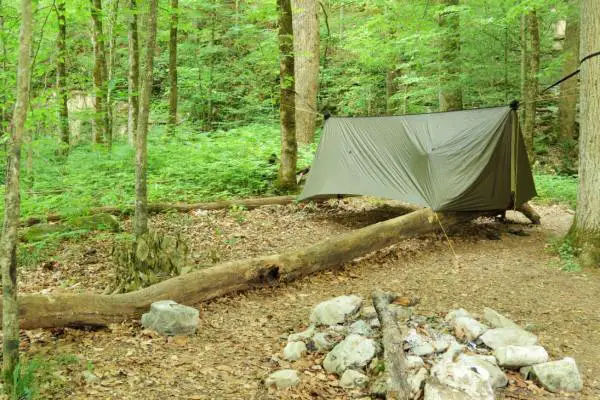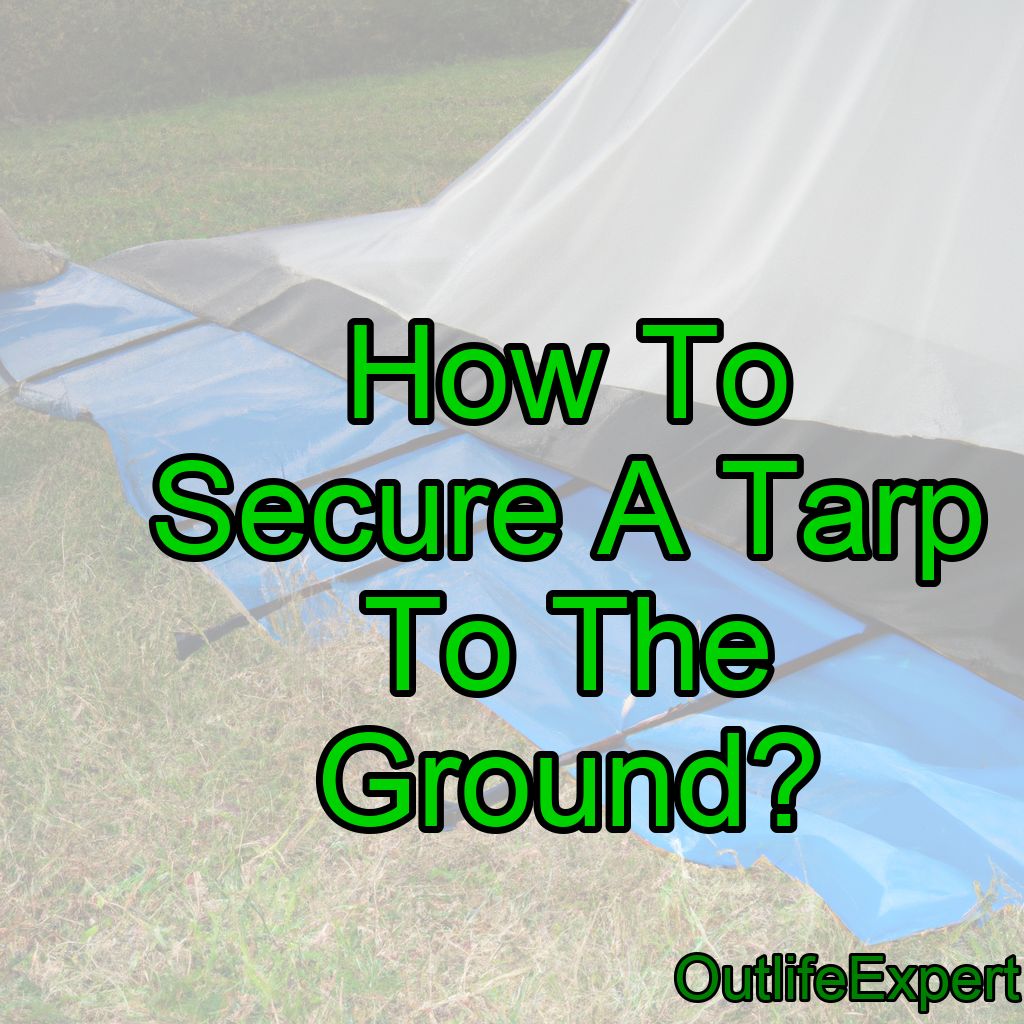Securing a tarp to the ground is an essential skill for any outdoor enthusiast. Whether you’re camping in the woods, tailgating at a football game or simply needing shade from the sun, having your tarp firmly secured can make all the difference when it comes to enjoying your time outdoors.
To secure a tarp to the ground, follow these steps:
1. Choose the right location: Select a flat, even surface free of sharp objects that could puncture the tarp.
2. Lay out the tarp: Spread the tarp on the ground, ensuring it is fully extended and wrinkle-free.
3. Anchor the corners: Use tent stakes, pegs, or weights to anchor the four corners of the tarp. Insert the stakes through the grommets (metal eyelets) or loops at the corners, and angle them away from the tarp to create tension.
4. Secure the edges: If the tarp has additional grommets or loops along the edges, use more stakes or weights to anchor them. This will provide extra stability and prevent the tarp from flapping in the wind.
5. Create a windbreak: If you’re in a windy area, consider setting up a windbreak using a natural barrier (like bushes or trees) or a man-made one (like a fence or a row of sandbags).
6. Check for tension: Ensure the tarp is taut and secure, with no sagging or loose areas. Adjust the stakes or weights as needed to maintain tension.
7. Monitor and adjust: Periodically check the tarp and its anchors, especially during inclement weather. Adjust or replace stakes and weights as needed to keep the tarp secure.
Remember that these steps can be adapted to suit your specific needs and the materials you have available.
Here’s how you can do it right – and get those much-needed moments of freedom that we all crave!
Types Of Anchoring Systems
When it comes to securing a tarp or covering to the ground, there are several different anchoring methods available.
Take for instance the stakes and rope method – this classic solution is one of the most reliable ways to keep your tarp in place. It requires you drive small metal stakes into the ground around the perimeter of the tarp and then tie down securely with nylon-braided rope.

Bungee cords can also be used as an alternative, but they may not provide enough tension over time to keep your cover from blowing away.
For larger applications such as construction sites or outdoor events, sandbags make excellent anchor points when filled with dirt or gravel. Another great option is using ground loops that attach via grommets along the edge of your tarp and peg locks which hold them firmly in place.
These systems offer even more stability than traditional ropes and stakes alone – making sure your tarp will stay right where you need it! With these various options at hand, no matter what type of application you’re working on, you should have no problem finding a secure way to fasten down your tarps.
Transitioning seamlessly into our next topic…
Materials Needed For Securing
Securing a tarp to the ground is of utmost importance to ensure it can withstand inclement weather conditions, especially when camping outdoors.
You’ll need some essential items like stakes, ropes, bungee cords, tent pegs and sandbags for this task. It’s important to have enough materials on hand so you don’t run out during the process.
No matter what materials you’re using, make sure they are sturdy and durable enough for the job at hand – otherwise your tarp won’t stay put!
Be prepared with plenty of supplies so that you’ll be able to secure your tarp tightly in place. With the right combination of materials, you’ll be ready to tackle any outdoor adventure without worry or concern about the elements.
Now all that’s left is piecing together how these tools will work together to keep your tarp securely attached to the ground; let’s delve into those steps now…
Steps For Securing The Tarp
Anchoring the tarp is key, so you’ll want to make sure you choose an anchor point that’s strong and secure. To create tension and keep the tarp in place, use bungee cords, straps, or ropes to tie the corners down.
Anchoring The Tarp
Are you looking for the perfect way to secure your tarp? Look no further!
Anchoring the tarp is an important step in keeping it grounded and making sure everything stays in place.
To ensure that your weighted edges stay put, use ground stakes or peg loops to firmly attach each corner of the tarp to the ground.
It only takes a few minutes but will make all the difference when you’re out camping or hosting an outdoor event.
Make sure to find durable looped pegs and sturdy ground stakes so that you can keep your tarp securely fastened during windy weather or even light rain.
You don’t have to worry about any unwanted movement – just enjoy being outdoors!
Creating Tension
Once you’ve securely anchored your tarp to the ground, it’s time to create some tension. This will help keep the tarp from being blown away in strong winds or heavy rain and ensure that all of your gear stays safe underneath.
Pitching techniques like line lashing can be used to pull the sides tight and increase wind resistance.
Additionally, staking methods such as guy lines with adjustable hook-and-loop systems, tie downs with webbing straps, and ratcheting straps are great for giving extra tension if needed.
With these tools at hand, you’ll have no problem keeping everything snug and secure. So go ahead and enjoy nature – knowing that your camp is protected!
Tips For Securing The Tarp
Securing a tarp to the ground is an easy and efficient way of creating an outdoor shelter. With these simple steps, you can enjoy maximum protection from wind, water and debris while also providing additional ground cover.
Tie downs are essential for keeping your tarp in place – use ropes or bungee cords to secure it firmly at each corner. You’ll need some pegs too; make sure they’re heavy enough not to be shifted by strong gusts of wind yet don’t damage the fabric of the tarp when inserted into the ground.
Position them correctly so that the ties won’t slip out of their slots during bad weather conditions. The right placement will ensure optimum stability and wind protection.
Waterproofing is equally important if you want your shelter to last through all kinds of weather conditions. Make sure your tarp is coated with a waterproof sealant before installation, as this will help protect against rainwater seepage over time.
Additionally, pitch your shelter slightly off level – this helps drain away any excess moisture should there be any rainfall during your stay outside.
With these tips for securing a tarp to the ground in mind, you’ll be ready for whatever nature throws at you! From camping trips to beach days, knowing how to properly set up your shelter gives you peace of mind no matter where life takes you outdoors.
Frequently Asked Questions
What Is The Best Type Of Tarp To Use?
When you’re planning a camping adventure, choosing the right tarp to protect your gear is key. It doesn’t matter if you’re looking for a stakeless setup or one with stakes; there are different sizes and materials available that can accommodate various surface types.
However, picking the best type of tarp isn’t always easy since they all come with their own advantages and disadvantages. As an outdoor expert, I’m here to help guide you on making the right choice so you can enjoy your time outside without worrying about tarp maintenance.
What Is The Best Time Of Day To Secure A Tarp?
The best time of day to secure a tarp is just before sunset.
This will allow you to select the right stakes for your ground preparation, anchor weights for wind resistance and rain protection, and enough daylight to ensure proper installation.
It’s also important that you check on the tarp in the morning because strong winds during the night can loosen anchors or cause damage if not properly secured.
With some planning ahead, you can have peace of mind knowing your tarp is securely fastened so that it can withstand nature’s elements with ease.
How Can I Best Protect A Tarp Against Weather Conditions?
As an outdoor expert, I can tell you that protecting a tarp against weather conditions is essential if you want it to last.
Anchoring methods such as tie-down materials and ground protection are key to preventing wind damage and ensuring waterproofing solutions remain effective.
But the best way of doing this isn’t just about using the right resources; it’s also about recognizing how much freedom your tarp will give you when properly secured.
As long as you take the time to ensure every anchor point is secure, your tarp will provide invaluable shelter for adventures of all kinds!
What Is The Best Way To Secure A Tarp If I Don’t Have Any Tools?
Securing a tarp without tools can be tricky, but it is possible!
Sandbags, rocks or stakes are great anchor points for providing stability and protection against inclement weather.
If you don’t have access to these items, create ground loops with the corners of your tarp.
Tie each corner down in several places to provide a secure hold that won’t move even in strong winds.
With some creativity and ingenuity, you can easily protect yourself from outdoor elements without any special equipment!
How Long Does It Typically Take To Secure A Tarp?
Securing a tarp should not take more than 10-15 minutes for an experienced outdoors enthusiast.
Stakeless solutions provide the best protection against heavy winds and rain, but require some prior ground preparation to ensure that the tarp is held fast.
Additionally, it’s important to consider your tarp strength; as heavier tarps may require additional time and effort in order to be properly secured.
With proper planning and knowledge of stakeless solutions, you can quickly secure a tarp without relying on traditional tools or stakes – giving you peace of mind when enjoying outdoor activities such as camping, hiking, fishing and more!
Conclusion
Securing a tarp to the ground is an important step in protecting your outdoor space from the elements. With careful planning and attention to detail, you can ensure that your tarp stays put no matter what Mother Nature throws at it!
The first thing to consider when securing a tarp is the type of material you’re using – some tarps are more durable than others, so make sure you choose one that will stand up against changing weather conditions. It’s also best to secure your tarp during mid-day hours when temperatures are highest; this helps keep the fabric tight on the ground.
You don’t need any fancy tools either – all you really need is rope or bungee cords for larger areas, or pins and pegs for smaller spaces. On average, it should take about 30 minutes to properly secure a tarp if done correctly.
Overall, with patience and practice, anyone can learn how to securely attach their tarp down like a pro! A well-secured tarp creates a barrier between yourself and nature’s harsher elements – think of it as an invisible shield against wind and rain. So grab those ropes and get ready: it’s time to transform your outdoor space into a safe haven!




